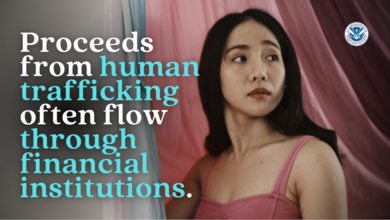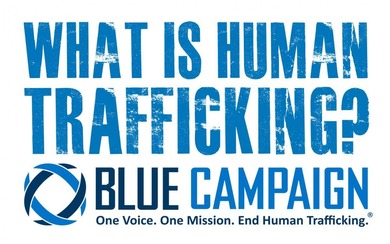 Human Trafficking
In the State Departments report on Trafficking In Persons 2022, it is estimated that human trafficking, both sex trafficking and forced labor, generate more than $150 billion in illicit profit for the traffickers and those who help facilitate the crime. Those profits often pass through traditional financial institutions or are used by traffickers to purchase real property or other personal assets.
On December 27, President Biden signed the “Countering Human Trafficking Act of 2022,” which codifies and expands the Department of Homeland Security’s Center for Countering Human Trafficking (CCHT). The bill authorizes $14 million to carry out the Act and ensures that the CCHT is staffed with at least 45 employees to help accomplish the Department’s critical work to combat human trafficking.
“The Countering Human Trafficking Act will increase and expand the CCHT’s effectiveness in targeting human traffickers around the globe, protecting victims, and supporting counter-trafficking work throughout DHS,” said Cardell T. Morant, CCHT Director. “Importantly, it will also facilitate the continued development of the Blue Campaign, the Department’s national human trafficking awareness initiative, designed to educate the American public about the signs of trafficking and the ways in which they can help trafficking victims and help bring suspected traffickers to justice. We are grateful to Congressional leadership and our partners for recognizing the value in this DHS center.”
Sign up for the Blue Campaign newsletter to regularly receive Campaign news, information about upcoming events, and ready-to-use social media content.

Recognizing key indicators of human trafficking is the first step in identifying victims and can help save a life. Here are some common indicators to help recognize human trafficking. You can also download or order the Blue Campaign indicator card, which is a small plastic card that lists common signs of trafficking and how to report the crime.
- Does the person appear disconnected from family, friends, community organizations, or houses of worship?
- Has a child stopped attending school?
- Has the person had a sudden or dramatic change in behavior?
- Is a juvenile engaged in commercial sex acts?
- Is the person disoriented or confused, or showing signs of mental or physical abuse?
- Does the person have bruises in various stages of healing?
- Is the person fearful, timid, or submissive?
- Does the person show signs of having been denied food, water, sleep, or medical care?
- Is the person often in the company of someone to whom he or she defers? Or someone who seems to be in control of the situation, e.g., where they go or who they talk to?
- Does the person appear to be coached on what to say?
- Is the person living in unsuitable conditions?
- Does the person lack personal possessions and appear not to have a stable living situation?
- Does the person have freedom of movement? Can the person freely leave where they live? Are there unreasonable security measures?
In addition to the terrible human cost associated with Human Trafficking, the estimated proceeds human trafficking generates often runs through traditional financial institutions. Human trafficking can happen in any country, it is important that finacial institutions assess how they are at risk from the laundering of the illicit proceeds from this crime. The private sector, and financial institutions, are on the frontline.

- Common Human Trafficking business fronts: Modeling and travel agencies, employment companies, “au pair” babysitting and international matchmaking services (mail order bride), massage parlors, hospitality, landscaping, construction, escort services, pornography, bars, strip clubs & cantinas, commercial cleaning services, carnivals
- Transactions conducted by individuals, escorted by a third party (under the pretext of requiring an interpreter or instances where the third party insists on being involved even if not warranted), to transfer funds to other countries; third party maintains possession and/or control of all documents or money
- Frequent transactions, inconsistent with expected activity or line of business, carried out by a business customer in apparent efforts to provide sustenance to individuals such as: payment for housing/lodging, regular vehicle rentals, purchases of large amounts of food, frequents purchases at pharmacies (e.g., medicine/condoms for victims)
- Payment to employment or student recruitment agencies that are not licensed/registered, or that have labor violations, or where the employer or employment agency serves as a custodian
- Frequent payments to online escort services for advertising, including small posting fees to companies of online classifieds as well as more expensive high-end advertising and website hosting companies (A customer’s account may share common identifiers, such as a telephone number, email, social media handle, or physical address, associated with escort agency websites and commercial sex advertisements)
- Business owner does not exhibit normal payroll expenditures such as wages, payroll taxes, social security contributions; payroll costs can be non-existent or extremely low for the size of the alleged operations, workforce, or business model
- Multiple accounts established for different businesses or persons with the same signatory powers on each account
- Frequent outbound wire transfers with no business or apparent lawful purpose, directed to countries at higher risk for human trafficking or to countries that are inconsistent with the customers expected activity (Customers frequently appear to move through, and transact from, different geographic locations in the United States. These transactions can be combined with travel and transactions in and to foreign countries that are significant conduits for human trafficking)
- Outbound wire transfers in small amounts, with no business or apparent lawful purpose by multiple individuals, sent at the same time from the same location to multiple recipients in the same geographical area; or (multiple wire transfers to the same beneficiary who may be in the US or in a Mexican city along the SW border)
- Business bank accounts that lack typical business expenses or account activity does not relate to the business; wire transfers from one business account to another business account that has no apparent ties
- Credit or debit processing for even dollar amounts, or cash transactions at time when atypical for business type (e.g., 2 am transactions)
- Leasing of high-end luxury vehicles and extravagant trips paid by electronic funds transfers from business bank accounts (trafficker’s lifestyle may be inconsistent with stated income/employment)
- Receipt of numerous incoming wire transfers or personal checks inconsistent with account type
- Checks deposited from a possible funnel account appear to be pre-signed, bearing different handwriting in the signature and payee fields
- Frequent exchange of small denomination bills for larger denomination bills by a customer who is not in a cash intensive industry
- Sudden increases in cash deposits, rapid turnover of funds and large volumes of cash deposits from unknown sources; substantial cash receipts are inconsistent with the customer’s line of business
- Money flows that do not fit common remittance patterns such as wire transfers that originate from countries with high migrant populations (Mexico, El Salvador, Honduras, Guatemala) directed to beneficiaries’ location in US or Mexican cities along the border (Customers frequently appear to move through, and transact from, different geographic locations in the United States. These transactions can be combined with travel and transactions in and to foreign countries that are significant conduits for human trafficking)
- Beneficiaries receiving wire transfers from countries with high migrant populations who are not nationals of those countries (see above bullet point)
- Wire senders may use similar transactional information, including commons accounts, addresses, phone numbers and IP addresses
- When questioned, the senders have no explanation for the purpose of the wire transfer and have no relation to the recipient of the funds
- New accounts that often reflect similar activity of that of the closed account

- Potential victim making recurring and frequent (less than one hour) trips between the casino floor and hotel rooms
- Multiple unrelated individuals making independent and short (less than one hour) trips to the same hotel room
- Potential victim will often meet with their “handler” in between visits to the casino floor or hotel room
- “Handler” can be observed monitoring the location and activity of one or more individuals, giving hand signals, briefly interacting with a potential victim, and then returning to an observation point
- Specific vehicle or driver making continual drop offs and pick-ups of one or more potential victims of similar age, that are similarly dressed, at a casino or hotel
- Vehicle or driver transporting one or more potential victims to multiple hotels for short periods of time, so they carry out forced sexual activities
- Vehicle driver as well as the potential victims exhibit similar behaviors at each casino or hotel
|









